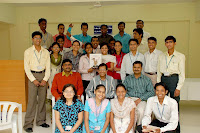.JPG)

OSB Indore students (1) Tarun Patel (2) Afrokhata Shabnam (3) Sarika Bahoria
participated in "Quest for Leaders" (QFL) competition organised by Indore Management Association (IMA) on 23rd January 2009. For the competition IMA had given the topic "Transforming Leadership, Ideas to Icons".













